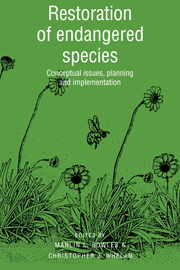Book contents
- Frontmatter
- Contents
- List of contributors
- Foreword
- Acknowledgments
- I Conceptual issues in restoration ecology
- II Restoration planning
- III Implemented restorations
- 10 The swift fox reintroduction program in Canada from 1983 to 1992
- 11 Restoration of the endangered black-footed ferret: a twenty-year overview
- 12 Development and implementation of a recovery program for the federally threatened Lakeside daisy (Hymenoxys acaulis var. glabra)
- 13 Demographic monitoring and the recovery of endangered plant populations
- IV Synthesis and future directions: biology, politics and reality
- Taxonomic Index
- Subject Index
11 - Restoration of the endangered black-footed ferret: a twenty-year overview
Published online by Cambridge University Press: 27 January 2010
- Frontmatter
- Contents
- List of contributors
- Foreword
- Acknowledgments
- I Conceptual issues in restoration ecology
- II Restoration planning
- III Implemented restorations
- 10 The swift fox reintroduction program in Canada from 1983 to 1992
- 11 Restoration of the endangered black-footed ferret: a twenty-year overview
- 12 Development and implementation of a recovery program for the federally threatened Lakeside daisy (Hymenoxys acaulis var. glabra)
- 13 Demographic monitoring and the recovery of endangered plant populations
- IV Synthesis and future directions: biology, politics and reality
- Taxonomic Index
- Subject Index
Summary
Introduction
The black-footed ferret (Mustela nigripes) is one of the world's most critically endangered mammals. Until about 1920, the carnivorous ferret occupied nearly 40 million ha over 12 Great Plains and Rocky Mountain states and two Canadian provinces. Agricultural interests and federal and state rodent control programs drastically eliminated ferret habitat–prairie dog (Cynomys spp.) colonies (the ‘prairie dog ecosystem’, Clark, Hinckley & Rich 1989b)–and fragmented the remainder into small patches, thus rendering isolated ferret populations highly vulnerable to extinction from various causes, including local catastrophes. Extensive searches in the late 1970s yielded no ferrets, and they were feared extinct, but in 1981 a small population was found near Meeteetse in northwestern Wyoming. By early 1986, only about ten individual ferrets were known, four in the wild and six in a single captive breeding facility. Fortunately, as of January, 1992, there were 175 ferrets in six captive breeding facilities, and 49 ferrets had been introduced to the wild. There is every reason to believe that the ferret will eventually be restored to the wild in viable numbers and distributions. Overviews of the ferret and prairie dog conservation and management effort are given by Casey, DuWaldt & Clark (1986), Clark (1986a), and Reading & Clark (1990).
The ferret's conservation history has been complex and unpromising. Both the ferret and determination of its critical habitat ranked very high in the first US Redbook of Endangered Wildlife in 1964, and again in a US Fish and Wildlife Service list of endangered species priorities in 1976.
- Type
- Chapter
- Information
- Restoration of Endangered SpeciesConceptual Issues, Planning and Implementation, pp. 272 - 297Publisher: Cambridge University PressPrint publication year: 1994
- 8
- Cited by



